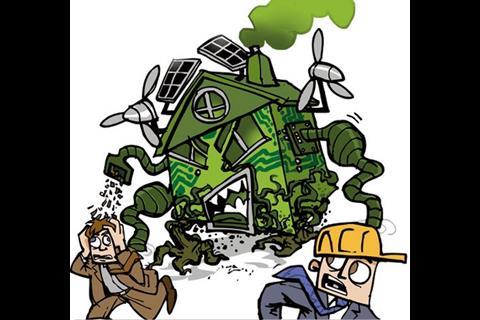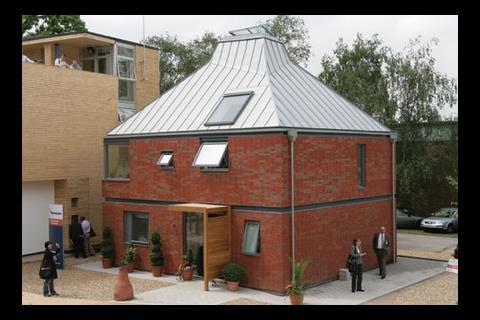The only thing that terrifies developers more than the idea that zero carbon homes could end up looking like an extraterrestrial des-res, is the thought that the technology may not even work.
“This is like going to the moon and back and doing it on a daily basis. In the past we have tended to do one-off demonstrations, now we need to be able to produce stuff that we can do again and again. It’s going to revolutionise the way we build housing in this country. If you are talking about the 2016 target, we are not in a position to do it at the moment.” This is how Nicholas Doyle, director of sustainability at affordable housing provider Places for People, sums up the industry’s challenge to reach the government’s target to make all new homes zero carbon by 2016. When champions of sustainability like Doyle are expressing these concerns, it’s little wonder the rest of the industry is alarmed.
A vision of the future was on offer at the BRE’s Offsite show at its headquarters near Watford last month. For the show, consultancies and construction companies teamed up to deliver a number of model houses that were either low or zero carbon to demonstrate the impact of the new Code for Sustainable Homes. The solutions were often technically ingenious, but the trip proved a painful reality check for many of the housebuilders who saw them. A senior industry source comments: “A lot of the people who went to Offsite were horrified by what they saw. There’s a significant division between the volume housebuilders and the type of housing being promoted by Offsite.”
Internal space standards of the demonstration homes were compromised by the sheer amount of kit needed to meet the code’s requirements. Many housebuilder visitors to the show were also left wondering how they might persuade Joe and Joanna Public to purchase the aesthetically unconventional homes on display.
A lot of the people who went to the BRE’s Offsite show were horrified by what they saw
Industry source
The mutterings at Offsite will be dismissed in many quarters as the kneejerk reactions of a stick in the mud industry. But facing up to the zero carbon challenge presents the housebuilding industry with a conundrum: how to incorporate the innovations required to hit the zero carbon target without alienating the buying public, either by producing homes that they are reluctant to buy or by incorporating unfamiliar technology. As National House Building Council operations director Ian Davis cautions: “They [housebuilders] have to be aware that they are competing with the second hand homes down the road.”
Many housebuilders question the fitness for purpose of the technologies on the market, particularly for renewable energy, and say they are looking at a very steep learning curve to reach zero carbon. Look at industry experience to date with the technology and you can see why. Miller Homes chief executive Tim Hough raised doubts to this magazine following potential problems with the photovoltaic roof tiles on its homes at Upton, Northamptonshire (Regenerate, April 2007). Domestic wind turbines have also come in for criticism, failing to generate energy in windless urban locations, and, in one instance, falling from the gables of a volume housebuilder’s homes on a site in north-west England.
Solar water heating panels are widely regarded as a useful and cost-effective tool for making the small-scale improvements that can help developers to reach the lower levels of the code. But the economics fail to stack up for electricity generating photovoltaic cells. “Solar thermal has a place for water heating, but PVs are very expensive for the savings that you get,” says Pooran Desai, co-founder of sustainable developer Bioregional Properties.
We are starting to over-insulate homes. In the south we have to think about cooling rather than heating
Pooran Desai
Ground source heat pumps, which suck the earth’s warmth to the surface, are generating a lot of industry interest and have been used successfully for 50 years in Canada and the USA. For every one kilowatt of energy needed to run a pump, another four can be generated. But James Redmayne, director of the sustainability section at construction consultant Northcroft, recently burnt a £20,000 hole in his client’s pocket when investigating the installation of a heat pump on a hospital project in Yorkshire. He explains: “We were investigating ground source heat pumps for a project in Airedale valley and spent an awful lot of money, only to find out that the ground was not suitable.” The rock was too near the surface, providing too thin a layer of soil to draw sufficient warmth from.
Better insulation is widely regarded as the panacea – a whole street can be lagged for less than the cost of a single PV cell. But Desai points out that insulation is going to become less of an issue as the climate warms up, as it is widely expected to. “At the higher levels of the code, a lot of people think we are probably starting to over-insulate homes. We have to think carefully about what the optimum levels of insulation are. It will be different from the north of England to the south, and we will have to think about cooling rather than heating.” Increasing existing insulation levels is going to produce “pretty minor” savings, he believes. “We are into the law of diminishing returns.”
For many developers, combined heat and power (CHP) has emerged as the favoured fix to the zero carbon conundrum. CHP, which uses the heat that would otherwise be wasted during electricity generation, is a tried and trusted technology. Biomass materials, such as wood chip, provide a low carbon fuel for a process that already saves a large amount of energy.
Local authorities have to start thinking about allocating sites for renewable energy provision
Stephen Hill, Beyond Green
But like heat pumps, CHP cannot be used everywhere. Schemes have to be relatively large to justify investment in installing and running a biomass plant. Ivan Ball, director of environmental consultancy Blue Sky Unlimited, estimates that a minimum of 200 homes are needed for a plant to be financially viable. Larger plants are more environmentally sustainable, too. Another issue with CHP is that plants generate about twice as much heat as electricity. Ball says: “CHP plants work, but only if you have another facility like a swimming pool or a school that you can put all the excess heat into.”
The industry is bound to experience teething problems and challenges with new technology, but, Stephen Hill, research director of sustainable development consultancy Beyond Green, says big picture solutions will be needed. “Everybody thinks it’s about buildings,” he says, “but if you want to get up to the levels of the higher code, it has to be more than buildings. It’s going to be about the careful masterplanning of the site, while local authorities have to start thinking about allocating sites for renewable energy provision and having conversations with people who are going to supply it.”
With a long track record as a committed environmentalist, Desai is optimistic. “There are lots of different technologies coming through; it’s changing all of the time,” he says. While he thinks there is still much room for improvement by the housebuilding industry, he shares some of his less enlightened colleagues’ concern that the current focus of government policy is too narrow. “One of the dangers is that we are trying to drive renewable energy policy through building regulations and at the level of the individual home.”
“From an environmental perspective, I am not convinced that the higher levels are economically deliverable and are driven by ideology rather than practicality. It’s not a very cost-effective way of delivering a renewable energy future.”
Source
RegenerateLive
























No comments yet